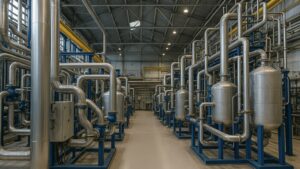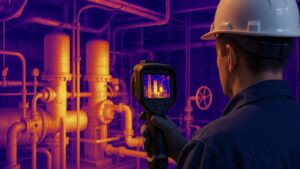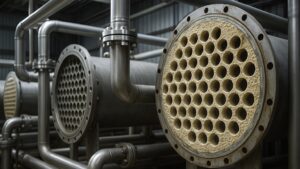The maritime industry faces an immense challenge. It must significantly reduce its climate impact. Developing green corridor operations emerges as a pivotal solution. Ports and harbors play a crucial role here. They serve as gateways for adopting transformative green technologies. These innovations can make maritime operations far more sustainable.
This comprehensive article explores the cutting-edge port technologies enabling this transition. It covers alternative fuel infrastructure, electrification solutions, energy storage systems, and more. These groundbreaking innovations are revolutionizing ports and shipping operations worldwide. They are rendering these activities greener and more efficient. So, let us look deeply into technologies enabling green corridor operations.
Green Corridor Operations: Alternative Fuel Infrastructure
The change towards alternative fuels is crucial. It helps to decarbonize the maritime industry. So, ports play a central role in this. They must invest in the infrastructure necessary to bring this shift. It is the only way various fuel sources will get the necessary support. Furthermore, various approaches are required for this as it faces several challenges. It includes the need for specialized storage facilities, piping systems, and bunkering stations tailored to handle each fuel type safely:
Liquefied Natural Gas Bunkering Facilities
As a transitional fuel, LNG has become increasingly popular in the marine sector. The reason stands to be its lower carbon footprint. So, compared to traditional marine fuels, it is vital in the journey towards zero emissions. Ports are keen to invest in LNG bunkering infrastructure. This is to accommodate the growing number of vessels that run on LNG. It consists of specific bunkering vessels, cryogenic piping systems, and storage tanks.
Moreover, to establish a LNG bunkering facility requires a close partnership. This is between port authorities, LNG suppliers, and regulatory bodies. It helps to ensure full compliance with safety standards and regulations. Additionally, ports must take the logistical challenges of transporting or storing LNG into consideration. They should also see the potential need for onsite liquefaction facilities.
Biofuel Bunkering & Facilities for Storage
Conventional marine fuels can be replaced with excellent biofuels such as biodiesel and biomethane. They come from renewable biomass sources. Ports must make dedicated storage tanks and bunkering stations to handle these fuels safely and in the right manner.
A reliable supply chain is one of the main issues with biofuel infrastructure. This is because biofuel depends on nearby biomass sources and is decentralized. So, ports must ensure collaboration with biofuel producers and distributors. It will solve the challenge of a steady supply chain.
Ammonia & Hydrogen Bunkering Infrastructure
Two new, highly promising zero-emission marine fuels are ammonia and hydrogen. To solve safety concerns, their infrastructure necessitates special designs. As ammonia is caustic and corrosive, it needs specific handling equipment, pipe infrastructure, and storage tanks. Moreover, facilities for handling, compression, and storage must be specifically designed because of the great flammability of hydrogen.
Green Corridor Operations: Electrification Solutions
Electrification represents another vital component of the maritime energy transition. Ports spearhead efforts to enable shore power and vessel electrification port technologies adoption.
Shore Power (Cold Ironing) Infrastructure
When a yacht is berthed, shore power, also known as cold ironing or alternative maritime power (AMP), enables it to connect to land-based electrical infrastructures. This eliminates running auxiliary engines, lowering emissions significantly. Implementing shore power requires substantial investments in electrical infrastructure upgrades. This includes high-voltage cabling, transformers, switchgear, and potentially dedicated substations to meet heightened power demands without compromising existing operations.
Vessel Electrification and Charging Infrastructure
Beyond shore power, ports explore solutions supporting vessel electrification, such as battery charging stations and hybrid power systems. These enable vessels to operate partially or fully on battery power during port calls and coastal voyages, minimizing emissions. Requisite charging infrastructure encompasses high-power charging stations and robust cable management systems to ensure seamless operations. Ports may also need battery swapping or leasing facilities to accommodate vessels with finite onboard energy storage.
Hybrid Power Systems and Alternative Maritime Power (AMP)
Hybrid marine power systems combine traditional engines with electric motors and energy storage, allowing operation in different modes based on requirements and conditions. This configuration can drastically cut emissions, especially during maneuvering and port stays. Alternative Maritime Power (AMP) systems facilitate secure power transfer between shore-based sources and berthed vessels, reducing onboard generation needs and associated emissions. AMP demands specialized electrical infrastructure and sophisticated power management capabilities.
Green Corridor Operations: Energy Storage Systems
Integrating renewable energy sources like solar and wind is paramount for ports to realize sustainability goals and support green corridor operations. However, their intermittent nature challenges reliable, consistent power provision. Energy storage systems solve this by banking the extra renewable generation. This is for discharge during low production or high demand time. As a result, it ensures uninterrupted operations.
Battery Energy Storage System
BESS is gaining rapid traction in ports. The reason for this is its scalability, flexibility, and timely response. Moreover, using lithium-ion or flow battery technologies, BESS installations can range heavily, This is from localized to massive utility-scale deployments. BESS absorbs and stores surplus renewable energy for later discharge, maintaining a stable power supply. They also provide vital backup capacity during grid outages, enhancing operational resilience and continuity.
Hydrogen Energy Storage Systems
Hydrogen storage gives a great solution for large-scale long-duration storage of energy. The excess electricity from renewable sources is used. It produces hydrogen via electrolysis. This can then be stored for conversion back into electricity. This is using fuel cells or generators powered by hydrogen when needed. This approach perfectly complements renewable power integration initiatives within ports, reducing dependence on fossil fuels.
Thermal Energy Storage Systems
These systems store energy in the form of cold or heat. These can be used for various uses. It includes heating, cooling, and industrial processes as well. In the use of ports, TESS can be used to store excess heat or cold. These can be generated during port operation or from sources of renewable energy.
TESS can be particularly useful for ports located in areas with significant temperature variations, as they can provide heating or cooling as needed, reducing the energy demand and associated emissions from conventional heating and cooling systems.
Green Corridor Operations: Digital Platforms and Smart Port Solutions
The maritime domain is undergoing rapid digital transformation. Ports lead the charge in adopting cutting-edge port technologies optimizing operations, boosting efficiency, and minimizing environmental impact. Digital platforms and smart solutions unlock immense potential for enabling greener corridor operations through real-time monitoring, data-driven decision-making, and seamless cross-stakeholder coordination.
Port Community Systems (PCS) and Port Management Information Systems (PMIS)
PCS and PMIS are advanced digital platforms facilitating real-time information and data exchange between diverse port stakeholders – terminal operators, shipping lines, customs authorities, logistics providers, and more. By streamlining processes and reducing cumbersome paperwork, PCS/PMIS enhances operational efficiency while curtailing associated emissions. These systems combine IoT, sensor data, envy monitoring, tracking of vessels, and more. So, it provides complete visibility driving informed decision-making.
Internet of Things and Sensor Networks
IoT devices and ubiquitous sensor networks are changing port operations. They are enabling pervasive real-time monitoring and acquisition of data across all aspects of activities. So, it includes energy consumption, emissions, equipment performance, asset tracking, and more. This small operational data joined with advanced analytics and ML algorithms allows the identification of inefficiencies. It also provides opportunities for optimization so that the environmental footprint is minimal. Moreover, IoT solutions can unlock predictive maintenance capabilities. So, it can reduce downtime and also extend the lifecycle of the infrastructure and assets.
AI and ML
Ports today use cutting-edge AI and machine learning technologies. It helps to intelligently optimize the green corridor operations. It also helps in enhancing decision-making and elevating sustainability goals. These algorithms can ingest and analyze vast datasets. This is from IoT development, vessel tracking systems, weather forecasts, and more. They discern patterns and model scenarios accurately. It also recommends the best course of action. These smart technologies find applications across the port’s activities – vessel traffic management, berth allocation, cargo handling, energy consumption monitoring, and more – driving emissions reductions through efficiency gains.
Digital Twins and Virtual Modeling
Digital twins and virtual modeling represent an innovative frontier enabling the creation of rich digital replicas replicating physical port assets and operations virtually. These high-fidelity simulated environments can be employed to safely evaluate the impacts of prospective changes, new technologies, and process optimizations before real-world rollouts. Digital twins integrate live data streams from IoT deployments, historical records, meteorological conditions, and more to offer a comprehensive unified view for modeling. Such capabilities immensely enhance planning and decision-making abilities while accelerating sustainability efforts.
Green Corridor Operations: Innovative Vessel Technologies
Facilitating green corridor operations necessitates the parallel adoption of innovative vessel port technologies. Ports must closely collaborate with maritime stakeholders like shipbuilders and operators to ensure seamless integration and continual support for these solutions.
Vessel Electrification and Battery Power
Fully electric vessels and hybrid configurations with integrated battery systems are rapidly gaining traction for their ability to virtually eliminate emissions, especially during port calls and coastal transits. To accommodate this emergent vessel segment, ports must develop robust charging infrastructure comprising high-power charging stations and sophisticated cable management solutions. Battery swapping or leasing facilities may additionally become requisites for serving vessels with constrained onboard energy storage capacities.
Alternative Fuel Propulsion Systems
The maritime sector is actively developing and deploying alternative fuel-based propulsion systems in tandem with electrification. These encompass LNG, biofuel, ammonia, and hydrogen-fueled engines – each with its distinct advantages and operational challenges. Ports will need to establish compatible bunkering facilities, and bulk storage provisions and implement rigorous safety protocols aligned with each alternative fuel’s unique characteristics to support these vessel types.
Advanced Emission Control Technologies
While alternative fuels and propulsion architectures offer significant emissions reductions, advanced emission control technologies further augment sustainability by capturing harmful exhaust pollutants. Solutions like exhaust gas cleaning systems, selective catalytic reduction (SCR) units, and particulate filters play a pivotal role here. Ports can actively facilitate the adoption of such solutions by providing specialized maintenance services and streamlined waste reception facilities to handle operational byproducts responsibly.
To Sum Up
Innovative and sustainable solutions are paving the path towards net zero emissions in the maritime industry, enabling green corridor operations. The opportunities that the technologies we have discussed are vast and promising. However, partnerships and collaborations are equally important. One such opportunity for learning and networking is the upcoming Net Zero Ports and Harbours Summit.
So, if you are seeking to embark on a transformative journey by learning through innovative sessions and panel discussions by industry experts, then the summit in Barcelona, Spain, on March 14-15, 2024 is for you. The Net Zero Ports and Harbours Summit will cover essential areas like marine vessel electrification: Who is doing what around the globe, Developing and operating ports/harbours for the maritime energy transition, Storage and safety levels of different alternative fuels, Electricity charging infrastructure, and more. So, make sure you register right away to be ahead in the transition!





